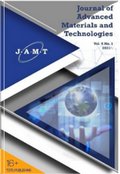
Journal of Advanced Materials and Technologies
Is a peer-reviewed scientific journal of research in materials science and related issues in materials physics and mechanics.
Journal publishes original articles, reviews, short reports written by both renowned scientists and young researchers that contribute to the development of modern materials science.
ISSN 2782-2192 (Print)
ISSN 2782-2206 (Online)
The journal promotes research and exchange of information in the field of theoretical and practical research into materials science, modeling of processes involved in the creation of new materials, including nanomaterials, their properties and application.
Scientific Journal is registered by the Federal Service for Supervision of Communications, Information Technology, and Mass Media (The certificate of registration PE No. FS 77-74804 of 25 January 2019 – periodical printed edition, journal)
The journal papers and metadata are available at Chemical Abstracts, CAS (American Chemical Society), Google Scholar, WorldCat, ROAR (Registry of Open Access Repositories), OpenAIRE (OpenAIRE - Open Access Infrastructure for Research in Europe), BASE (Bielefeld Academic Search Engine), RePEc: Research Papers in Economics, EBSCO.

Tambov State Technical University (TSTU)
Tambov, Russian Federation.

Merzhanov Institute of Structural Macrokinetics and Materials Sciences of Russian Academy of Sciences (ISMAN),
Chernogolovka, Moscow region, Russian Federation.
Circulation: 100 copies, periodicity: 4 times per year
Distribution: - Russia and abroad
Publisher: Tambov State Technical University
Rename information: «Advanced materials & technologies» (2016-2021), Print ISSN 2414-4606, Online ISSN 2541-8513
Chief Editor

Mikhail I. Alymov,
D.Sc.(Engineering), Professor, Corresponding Member of the Russian Academy of Sciences (RAS), Director of Merzhanov Institute of Structural Macrokinetics and Materials Sciences (ISMAN), RAS, Chernogolovka, Moscow Region, Russian Federation
Current issue
Articles
Formation of conductive layers based on carbon nanotubes by the Langmuir method
Oday Hassoon, Odai Salman, Tatiana Karatyshova, Ammar Al-Alwani, Maxim Gavrikov, Vladislav Mironyuk, Andrey Zakharevich, Mikhail Pozharov, Evgeny Glukhovskoy
🗏 : 008-018
DOI: https://doi.org/10.17277/jamt-2025-10-01-008-018
PDF:
Influence of graphene oxide additives on the filler structure and the physical and mechanical properties of carbon-graphite nanocomposite
Roman Balabanov, Tatyana Dyachkova, Anna Fedyushkina, Irina Gutnik, Georgy Titov, Elena Burakova, Evgeny Tugolukov
🗏 : 019-031
DOI: https://doi.org/10.17277/jamt-2025-10-01-019-031
PDF:
The effect of silica-modified carbon nanotubes additive to alkyd enamel coating on adhesion, corrosion resistance and bonding of reinforcement with cement
Mustafa Al-Khalidi, Alexander Blokhin
🗏 : 032-039
DOI: https://doi.org/10.17277/jamt-2025-10-01-032-039
PDF:
The impact of the operating mode of a planetary mill and gas atmosphere on mechanical alloying of powders in the Ni – Cu system
Anis Bobozhanov, Dmitry Kovalev, Sergey Vadchenko, Alexander Rogachev
🗏 : 040-048
DOI: https://doi.org/10.17277/jamt-2025-10-01-040-048
PDF:
Wood-polymer composites based on polyvinyl chloride reinforced with chrysotile asbestos
Ayaz Khantimirov, Lyailya Abdrakhmanova, Anvar Islamov, Rashit Nizamov, Ekaterina Suchkova
🗏 : 049-056
DOI: https://doi.org/10.17277/jamt-2025-10-01-049-056
PDF:
Preparation of composite materials based on oxide ceramics by the free SHS-compression
Andrey Chizhikov, Pavel Bazhin, Alexander Stolin
🗏 : 057-064
DOI: https://doi.org/10.17277/jamt-2025-10-01-057-064
PDF:
New insights into detonation synthesis and properties of nanodiamonds
Valerii Dolmatov, Dmitry Rudenko, Maxim Kiselev, Nataliya Satonkina, Natalia Lapchuk, Maria Blinova, Vladimir Senyut, Sergey Pisarevsky, Alla Nozhkina, Alexander Ershov
🗏 : 065-089
DOI: https://doi.org/10.17277/jamt-2025-10-01-065-089
PDF:



















